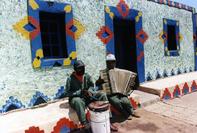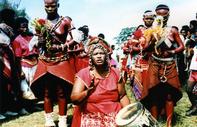Music at Ceremonies

From time to time, one of the men breaks from the group and leaps and prances before the chief, miming a battle attack. He is egged on by the others who stop singing and call him by his dancing name. He may also recite his own or the chief's praises. He then returns to his rank and the slow dancing movements continue. The mohobelo, performed by men, requires energy and endurance and is danced mainly in the evening, for amusement and entertainment.
Special Dances

The Basotho have a variety of musical instruments. The morupa, a small drum used at girls' initiations, is made from a clay pot over which a taut skin is stretched, and is struck with flat hands. The lekoko is made of a roll of hardened cow skin which is beaten with sticks, producing a dull thumping sound. Its use is restricted almost entirely to maqekha seances.
The lesiba consists of a horse-hair stretched along a stick between a quill and a holding bracket. Light sucking against the quill causes the horse-hair to vibrate, producing a haunting sound commonly accompanied by the player's voice. The thomo consists of a bow, across which a horse-hair or thin wire is stretched, and which is tautened with a wire fastening in the middle. The bow is attached to a calabash - or, in recent times, an old oil tin - which acts as a resonator. The instrument is played by plucking the string or picking it with a stick.